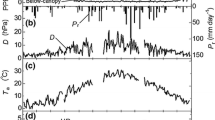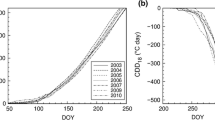Abstract
Canopy structure and light interception were measured in an 18-m tall, closed canopy deciduous forest of sugar maple (Acer saccharum) in southwestern Wisconsin, USA, and related to leaf structural characteristics, N content, and leaf photosynthetic capacity. Light attenuation in the forest occurred primarily in the upper and middle portions of the canopy. Forest stand leaf area index (LAI) and its distribution with respect to canopy height were estimated from canopy transmittance values independently verified with a combined leaf litterfall and point-intersect method. Leaf mass, N and A max per unit area (LMA, N/area and A max/area, respectively) all decreased continuously by over two-fold from the upper to lower canopy, and these traits were strongly correlated with cumulative leaf area above the leaf position in the canopy. In contrast, neither N concentration nor A max per unit mass varied significantly in relation to the vertical canopy gradient. Since leaf N concentration showed no consistent pattern with respect to canopy position, the observed vertical pattern in N/area is a direct consequence of vertical variation of LMA. N/area and LMA were strongly correlated with A max/area among different canopy positions (r2=0.81 and r2=0.66, respectively), indicating that vertical variation in area-based photosynthetic capacity can also be attributed to variation in LMA. A model of whole-canopy photosynthesis was used to show that observed or hypothetical canopy mass distributions toward higher LMA (and hence higher N/area) in the upper portions of the canopy tended to increase integrated daily canopy photosynthesis over other LMA distribution patterns. Empirical relationships between leaf and canopy-level characteristics may help resolve problems associated with scaling gas exchange measurements made at the leaf level to the individual tree crown and forest canopy-level.
Similar content being viewed by others

References
Aber JD (1979) A method for estimating foliage-height profiles in broad-leaved forests. J Ecol 67: 35–40
Baldocchi DD, Hutchison BA, Matt DR, McMillen RT (1985) Canopy radiative transfer models for spherical and known leaf inclination angle distributions: A test in an oak-hickory forest. J Appl Ecol 22: 539–555
Ball JT (1987) Calculations related to gas exchange. In: Zeiger E, Farquhar GD and Cowan IR (eds) Stomatal Function, Stanford University Press, Stanford, pp 445–476
Bingham GE, Coyne PI, Kennedy RB, Jackson WL (1980) Design and fabrication of a portable minicuvette system for measuring leaf photosynthesis and stomatal conductance under controlled conditions. Lawrence Livermore National Laboratory, Livermore, CA, UCRL-52895
Björkman O (1981) Responses to different quantum flux densities. In: Lange OL, Nobel PS, Osmond CB, Ziegler H (eds) Encyclopedia of Plant Physiology, Springer-Verlag, Berlin Heidelberg New York, New Series, vol 12A, pp 57–107
Bolstad PV, Gower ST (1990) Estimation of leaf area index in fourteen southern Wisconsin forest stands using a portable radiometer. Tree Physiol 4: 115–124
Caldwell MM, Meister H-P, Tenhunen JD, Lange OL (1986) Canopy structure, light microclimate and leaf gas exchange of Quercus coccifera L. in a Portuguese macchia: measurements in different canopy layers and simulations with a canopy model. Trees 1: 25–41
Campbell GS (1986) Extinction coefficients for radiation in plant canopies calculated using an ellipsoidal inclination angle distribution. Agr For Meteorol 36: 317–321
Campbell GS, Norman JM (1989) The description and measurement of canopy structure. In: Russell G, Marshall B, Jarvis PG (eds) Plant canopies: their growth, form and function. Cambridge University Press, Cambridge, pp 1–20
Chabot BF, Jurik TW, Chabot JF (1979) Influence of instantaneous and integrated light flux density on leaf anatomy and photosynthesis. Am J Bot 86: 940–945
Chazdon RL, Field C (1987) Determinants of photosynthetic capacity in six rainforest Piper species. Oecologia 73: 222–230
Curtis, JT (1959) The Vegetation of Wisconsin. University of Wisconsin Press, Madison, WI, USA, p 657
DeJong TM, Doyle JF (1985) Seasonal relationships between leaf nitrogen content (photosynthetic capacity) and leaf canopy light exposure in peach Prunus persica. Plant Cell Environ 8: 701–706
DeJong TM, Day KR, Johnson RS (1989) Partitioning of leaf nitrogen with respect to within canopy light exposure and nitrogen availability in peach (Prunus persica). Trees 3: 89–95
Eliás P, Kratochvílová I, Janous D, Marek M, Masarovicová E (1989) Stand microclimate and physiological activity of tree leaves in an oak-hornbeam forest I. Stand microclimate. Trees 4: 227–233
Ellsworth DS, Reich PB (1992) Leaf mass per area, nitrogen content and photosynthetic carbon gain in Acer saccharum seedlings in contrasting forest light environments. Funct Ecol 6: 423–435
Evans JR (1989) Photosynthesis and nitrogen relationships in leaves of C3 plants. Oecologia 78: 9–19
Field C (1983) Allocating leaf nitrogen for the maximization of carbon gain: leaf age as a control on the allocation program. Oecologia 56: 341–347
Field C (1991) Ecological scaling of carbon gain to stress and resource availability. In: Mooney HA, Winner WE, Pell EJ (eds) Response of Plants to Multiple Stresses. Academic Press, New York, pp 35–65
Field CB, Mooney HA (1986) The photosynthesis-nitrogen relationship in wild plants. In: Givnish TJ (ed) On the Economy of Plant Form and Function, Cambridge University Press, Cambridge, pp 25–55
Fownes JH (1985) Water use and primary production in Wisconsin hardwood forests. PhD dissertation, University of Wisconsin, Madison, WI, p 131
Gulmon SP, Chu CC (1981) The effects of light and nitrogen on photosynthesis, leaf characteristics, and dry matter allocation in the chaparral shrub, Diplacus aurantiacus. Oecologia 49: 207–212
Gutschick VP, Wiegel FW (1988) Optimization of the canopy photosynthetic rate by patterns of investment in specific leaf mass. Am Nat 132: 67–86
Hanson PJ, McRoberts RE, Isebrands JG, Dixon RK (1987) An optimal sampling strategy for determining CO2 exchange rate as a function of photosynthetic photon flux density. Photosynthetica 21: 98–101
Hirose T, Werger MJA (1987) Maximizing daily canopy photosynthesis with respect to the leaf allocation pattern in the canopy. Oecologia 72: 520–526
Hiscox JD, Israelstam GF (1979) A method for the extraction of chlorophyll from leaf tissue without maceration. Can J Bot 57: 1332–1334
Hollinger DY (1989) Canopy organization and foliage photosynthetic capacity in a broad-leaved evergreen montane forest. Funct Ecol 3: 53–62
Jarvis PG, Leverenz JW (1983) Productivity of temperate deciduous and evergreen forests. In: Lange OL, Nobel PS, Osmond CB, Ziegler H (eds) Encyclopedia of Plant Physiology, Springer-Verlag, Berlin Heidelberg New York, New Series, vol 12D, pp 233–280
Jurik TW (1986) Temporal and spatial patterns of specific leaf weight in successional northern hardwood tree species. Am J Botany 73: 1083–1092
Jurik TW, Briggs GM, Gates DM (1985) A comparison of four methods for determining leaf area index in successional hardwood forests. Can J For Res 15: 1154–1158
Lang ARG (1987) Simplified estimate of leaf area index from transmittance of the sun's beam. Agr For Meteorol 41: 179–186
Lang ARG, Xiang (1986) Estimation of leaf area index from transmission of direct sunlight in discontinuous canopies. Agr For Meteorol 37: 229–243
Leuning R, Wang YP, Cromer RN (1991) Model simulations of spatial distributions and daily totals of photosynthesis in Eucalyptus gradis canopies. Oecologia 88: 494–503
Lewandowska M, Jarvis PG (1977) Changes in chlorophyll and carotenoid content, specific leaf area and dry weight fraction in Sitka spruce, in response to shading and season. New Phytol 79: 247–256
Mooney HA, Gulmon SL (1979) Environmental and evolutionary constraints on the photosynthetic characteristics of higher plants. In: Solbrig OT, Jain S, Johnson GB, Raven PH (eds) Topics in Plant Population Biology, Columbia University Press, New York, pp 316–337
Nobel PS, Zaragoza LJ, Smith WK (1975) Relation between mesophyll surface area, photosynthetic rate, and illumination level during development for leaves of Plectranthus parviflorus Henckel. Plant Physiol 55: 1067–1070
Norman JM (1980) Interfacing leaf and canopy light interception models. In: Hesketh JD, Jones JW (eds) Predicting Photosynthesis for Ecosystem Models, vol 2, CRC Press, Boca Raton, Florida, pp 49–67
Norman JM (1993) Scaling processes between leaf and canopy levels. In: Ehleringer JR, Field C (eds) Scaling Processes between Leaf and Landscape Levels, Academic Press, New York, pp 41–76
Norman JM, Jarvis PG (1975) Photosynthesis in Sitka spruce (Picea sitchensis (Bong.) Carr V. Radiation penetration theory and a test case. J Appl Ecol 12: 839–878
Norman JM, Campbell GS (1989) Canopy structure. In: Pearcy RW, Mooney HA, Ehleringer JR, Rundel PW (eds) Plant Physiological Ecology: Field Methods and Instrumentation, Chapman and Hall, New York, pp 301–325
Oberbauer SF, Strain BR (1986) Effects of canopy position and irradiance on the leaf physiology and morphology of Pentaclethra macroloba (Mimosaceae). Am J Bot 73: 409–416
Oren R, Schulze E-D, Matyssek R, Zimmermann R (1986) Estimating photosynthetic rate and annual carbon gain in conifers from specific leaf weight and biomass. Oecologia 70: 187–193
Pearcy RW (1990) Sunflecks and photosynthesis in plant canopies. Ann Review Plant Physiol Plant Mol Biol 41: 421–453
Pierce LL, Running SW (1988) Rapid estimation of coniferous forest leaf are index using a portable integrating radiometer. Ecology 69: 1762–1767
Reich PB, Ellsworth DS, Kloeppel BD, Fownes JH, Gower ST (1990) Vertical variation in canopy structure and CO2 exchange of oak-maple forests: influence of ozone, nitrogen, and other factors on simulated canopy carbon gain. Tree Physiol 7: 329–345
Reich PB, Walters MB, Ellsworth DS (1991) Leaf development and season influence the relationships between leaf nitrogen, leaf mass per area and photosynthesis in maple and oak trees. Plant Cell Environ 14: 251–259
Reich PB, Walters MB, Ellsworth DS, Uhl C (1993) Photosynthesis-nitrogen relationships in Amazonian tree species. I. Patterns among species and communities. Oecologia (in press)
Reich PB, Walters MB (1993) Photosynthesis-nitrogen relationships in Amazonian tree species. II. Influences on mass- and area-based expressions. Oecologia (in press)
Ross J (1981) The Radiation Regime and Architecture of Plant Stands. Dr W Junk, The Hague, pp 390
Schulze E-D, Fuchs M, Fuchs MI (1977) Spatial distribution of photosynthetic capacity and performance in a mountain spruce forest of northern Germany. III. The significance of the evergreen habit. Oecologia 30: 239–248
Seemann JR, Sharkey TD, Wang JL, Osmond CB (1987) Environmental effects on photosynthesis, nitrogen-use efficiency and metabolite pools in leaves of sun and shade plants. Plant Physiol 84: 796–802
von Caemmerer S, Farquhar GD (1981) Some relationships between the biochemistry of photosynthesis and the gas exchange of leaves. Planta 153: 376–387
Walters MB, Field C (1987) Photosynthetic light acclimation in two rainforest Piper species with different ecological amplitudes. Oecologia 72: 449–456
Witkowski ETF, Lamont BB (1991) Leaf specific mass confounds leaf density and thickness. Oecologia 88: 486–493
Author information
Authors and Affiliations
Rights and permissions
About this article
Cite this article
Ellsworth, D.S., Reich, P.B. Canopy structure and vertical patterns of photosynthesis and related leaf traits in a deciduous forest. Oecologia 96, 169–178 (1993). https://doi.org/10.1007/BF00317729
Received:
Accepted:
Issue Date:
DOI: https://doi.org/10.1007/BF00317729



